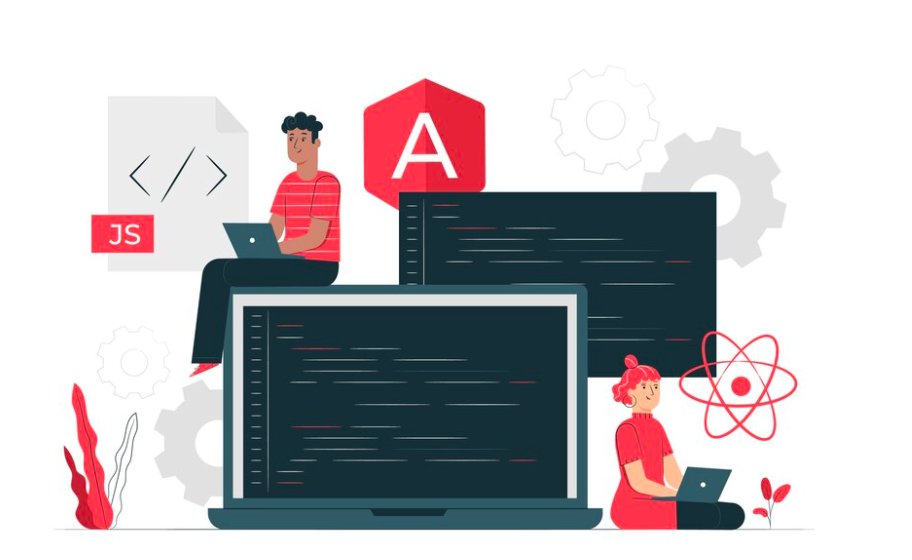In the dynamic landscape of 2023, JavaScript development flourishes with essential JavaScript tools such as React.js, Vue.js, and Angular, empowering efficient UIs and robust front-end solutions. JavaScript technologies like Node.js and Express.js remain pivotal for server-side and web app development, while JavaScript library Redux stands as a reliable state management solution. jQuery maintains its relevance in the JavaScript ecosystem, and D3.js excels in crafting compelling JavaScript data visualizations. Innovations like Next.js and Svelte redefine JavaScript web app development. This rich JavaScript ecosystem of libraries and frameworks ensures developers can effectively meet diverse JavaScript project requirements in an ever-evolving technological landscape.
React.js

React.js is a powerful JavaScript library for building user interfaces, renowned for its simplicity and efficiency. Its key features include:
- Declarative Syntax: React uses a declarative syntax that makes it easy to understand and predict the UI’s appearance based on the application’s state.
- Component-Based Architecture: The component-based structure promotes code reusability and maintainability, allowing developers to build complex UIs by combining independent, self-contained components.
- Virtual DOM: React employs a virtual DOM to optimize rendering, enhancing performance by selectively updating only the parts of the actual DOM that have changed.
- Unidirectional Data Flow: React enforces a unidirectional data flow, ensuring a predictable and manageable state management process by controlling the flow of data throughout the application.
- Ecosystem and Community: With a vast ecosystem of libraries and a large and active community, React offers extensive resources and support, making it a popular choice for building scalable and interactive web applications.
Vue.js
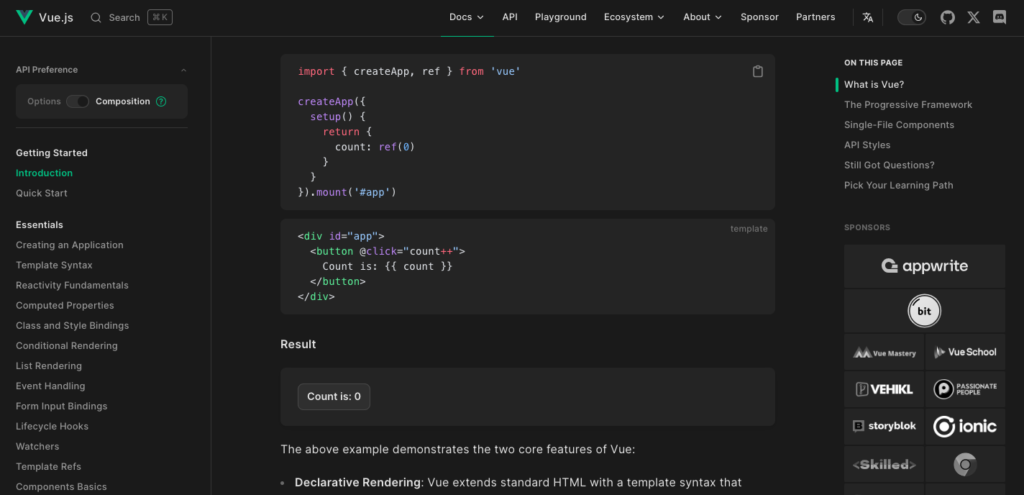
Vue.js, a progressive JavaScript framework, offers several benefits that contribute to its popularity among developers. Here are five key advantages:
- Progressive Framework: Vue.js is incrementally adoptable, allowing developers to integrate it gradually into existing projects while leveraging its full potential.
- Reactive Data Binding: Vue.js provides seamless and reactive data binding, ensuring automatic updates to the UI when data changes, simplifying state management.
- Component-Based Architecture: The framework follows a modular component-based structure, promoting reusability and maintainability in code development.
- Directives and Templates: Vue.js offers easy-to-use directives and templates for declarative rendering, enabling concise and readable code for building dynamic interfaces.
- Ecosystem and Community Support: With a thriving ecosystem and a supportive community, Vue.js provides a rich set of tools, libraries, and resources to enhance the development experience.
Angular
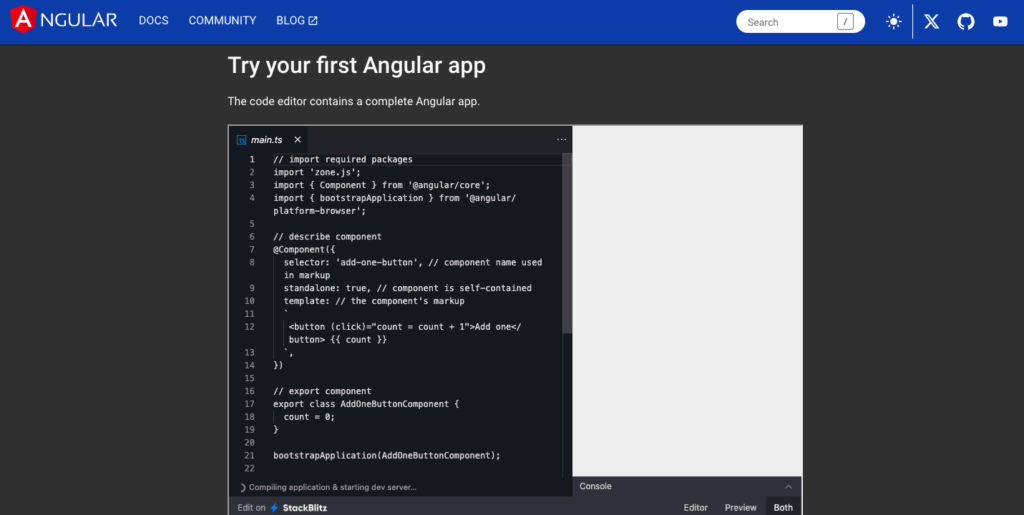
Angular, a powerful front-end framework maintained by Google, offers several benefits for web application development:
- Modularity: Angular’s modular architecture promotes organized code through components, making it scalable and easy to maintain.
- Two-Way Data Binding: Automatic synchronization between the model and the view simplifies development and enhances real-time interactivity.
- Dependency Injection: Built-in dependency injection facilitates the development of loosely coupled, testable components, improving code quality.
- Cross-Platform Development: Angular supports cross-platform development for web, mobile, and desktop applications, ensuring code reusability.
- Powerful Templating: Angular’s expressive templating system allows developers to create dynamic and responsive user interfaces with ease.
Angular’s comprehensive feature set, active community support, and continuous updates contribute to its popularity in building modern, scalable, and maintainable web applications.
Node.js
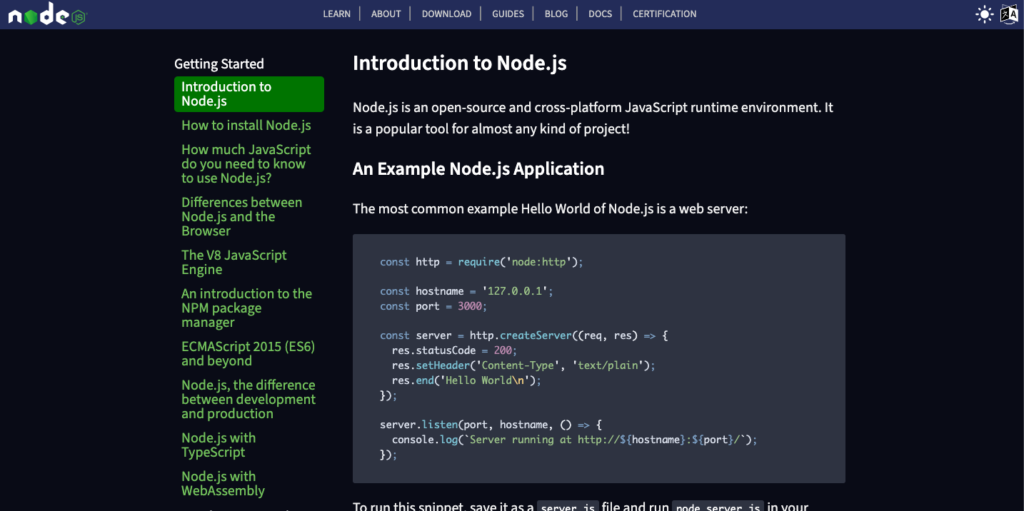
Node.js, a server-side JavaScript runtime, offers numerous benefits for developers, making it a popular choice for building scalable and high-performance applications. Here are five key advantages of using Node.js:
- Asynchronous I/O: Node.js enables non-blocking, event-driven architecture, optimizing I/O operations and enhancing application performance.
- Scalability: It supports scalable applications with the ability to handle a large number of concurrent connections, making it suitable for high-traffic websites.
- Vast Module Library: Node.js boasts a rich ecosystem of modules through npm (Node Package Manager), simplifying development with readily available packages.
- Cross-Platform Compatibility: Node.js is compatible with various operating systems, providing flexibility for developers to deploy applications across different platforms.
- Community Support: With an active and vibrant community, Node.js receives continuous updates, ensuring it stays current with evolving industry standards and best practices.
These benefits, among others, contribute to Node.js’ widespread adoption and success in powering a variety of applications, from small startups to large-scale enterprises.
Express.js

Express.js, a minimalist and flexible Node.js web application framework, offers several benefits for developers building web applications. Here are five key advantages:
- Routing: Express offers a robust routing system that allows developers to define routes for handling different HTTP methods and URLs, making it easy to create a well-organized API structure.
- Middleware: The middleware support in Express enables the incorporation of additional functionality to the request-response cycle, enhancing features like authentication, logging, and error handling.
- Template Engines: Express supports various template engines, such as EJS and Pug, facilitating the dynamic generation of HTML pages on the server side.
- HTTP Utility Methods: It provides utility methods for handling common HTTP tasks, streamlining the process of sending responses, parsing requests, and managing cookies.
- Extensibility: Express is highly extensible, allowing developers to integrate additional modules and middleware to cater to specific project requirements, making it adaptable for a wide range of applications.
Express.js’s simplicity, middleware support, routing capabilities, active community, and flexibility make it a popular choice for developers looking to build scalable and maintainable web applications using Node.js.
Redux.js

Redux.js, a state management library for JavaScript applications, offers several benefits that contribute to a more organized and maintainable codebase. Here are five key advantages of using Redux:
- Predictable State Management: Enforces a unidirectional data flow, providing clarity on how the application state evolves.
- Centralized State: Maintains the entire application state in a centralized store, simplifying access and management.
- Debugging Tools: Includes tools like Redux DevTools for real-time inspection of state changes, aiding in debugging.
- Middleware Support: Supports middleware for extending store functionality, enhancing adaptability.
- Scalability and Maintainability: Promotes a scalable and maintainable architecture by separating concerns and simplifying complex state management.
While Redux offers these advantages, it’s important to note that it might introduce some additional boilerplate code compared to simpler state management solutions. The decision to use Redux should be based on the specific needs and complexity of your application.
jQuery

jQuery, despite being somewhat older and not as prominent in modern web development as it once was, still offers several benefits. Here are five advantages of using jQuery:
- DOM Manipulation: jQuery makes DOM manipulation effortless, enabling easy traversal and modification of HTML documents.
- Event Handling: Streamlined event handling simplifies interactive web design, allowing developers to respond efficiently to user actions.
- Ajax Support: Built-in Ajax functions facilitate asynchronous communication, enhancing the user experience by enabling dynamic, seamless data loading.
- Animation: jQuery’s animation capabilities bring websites to life with smooth transitions and effects, enhancing visual appeal.
- Cross-Browser Compatibility: jQuery abstracts browser inconsistencies, ensuring consistent behavior across various browsers, reducing compatibility challenges for developers.
While jQuery’s prominence has diminished with the rise of modern JavaScript frameworks and libraries, its simplicity and ease of use still make it a viable choice for certain projects, especially those with straightforward requirements or where compatibility with older browsers is a consideration.
D3.js
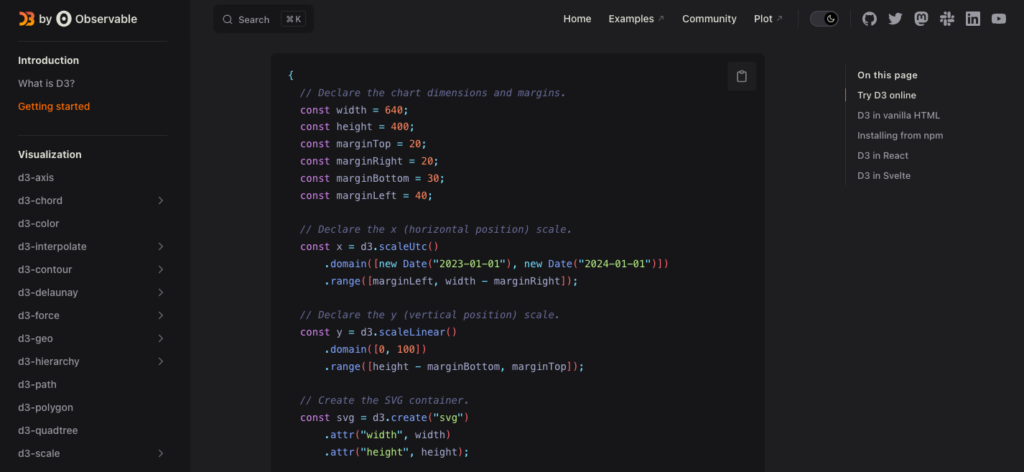
D3.js, or Data-Driven Documents, is a powerful JavaScript library for creating dynamic and interactive data visualizations in web browsers. Here are five benefits of using D3.js:
- Data Binding:
- D3.js binds data to the Document Object Model (DOM), allowing seamless synchronization between data changes and visual representation.
- DOM Manipulation:
- It facilitates efficient manipulation of HTML, SVG, and CSS elements, enabling the creation of complex and customizable visualizations.
- Scalability:
- D3.js handles large datasets gracefully, providing methods for scaling and transforming data to fit a wide range of visualizations.
- Transitions and Animations:
- D3.js simplifies the creation of smooth transitions and animations, enhancing the user experience and conveying information dynamically.
- Modularity:
- D3.js promotes a modular and extensible code structure, allowing developers to reuse components and build a variety of interactive data visualizations with ease.
While D3.js offers numerous benefits, it may have a steeper learning curve compared to other visualization libraries due to its flexibility and lower-level nature. However, the investment in learning D3.js is often rewarded with the ability to create highly customized and visually appealing data visualizations tailored to specific project requirements.
Next.js

Next.js is a popular React-based framework that brings several benefits to web development. Here are five key advantages:
- Server-Side Rendering (SSR):
- Enables faster page loads and improved SEO by rendering pages on the server, delivering pre-rendered content to the client.
- Zero Configuration:
- Requires minimal setup, allowing developers to focus on building features rather than spending time on complex configurations.
- Automatic Code Splitting:
- Optimizes performance by breaking down code into smaller chunks, loading only what’s necessary for each page, and reducing initial load times.
- API Routes:
- Simplifies backend development by allowing the creation of API endpoints within the same project, streamlining communication between the frontend and backend.
- Static Site Generation (SSG):
- Generates static HTML at build time, offering both the benefits of static sites and dynamic updates when needed, ensuring a flexible and efficient development process.
Overall, Next.js streamlines the development process, enhances performance, and provides a flexible and efficient solution for building modern web applications.
Svelte
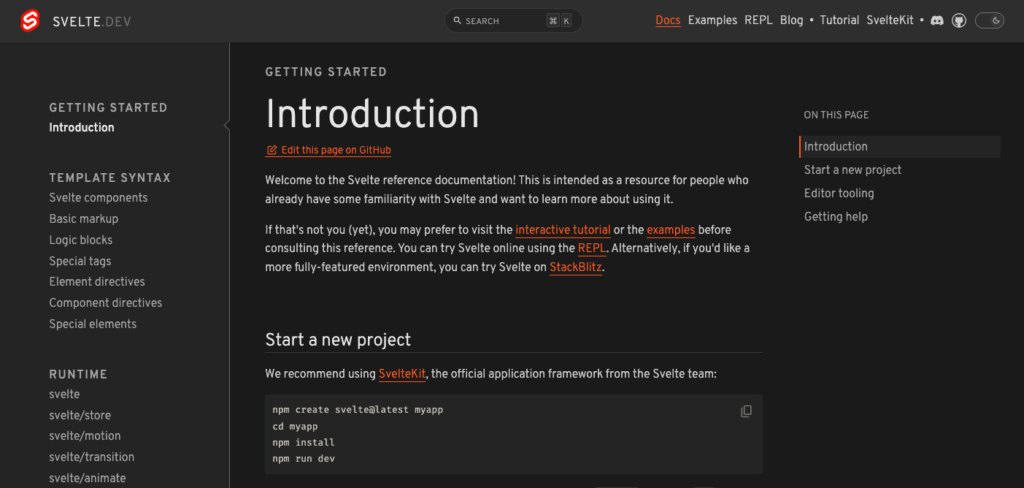
Svelte, a modern JavaScript framework, offers several benefits that set it apart from other frameworks. Here are five key advantages of using Svelte:
- Zero-runtime Overhead:
- Svelte shifts the work to build time, resulting in smaller and faster applications by eliminating the need for a runtime library in the final bundle.
- Reactive Declarations:
- Svelte leverages a reactive paradigm, enabling automatic updates to the DOM based on state changes without the need for explicit framework-specific syntax.
- Component-based Architecture:
- Svelte encourages a component-based approach for building UI elements, facilitating code modularity and reusability.
- Effortless State Management:
- State management in Svelte is intuitive, as it seamlessly integrates reactive statements for handling state changes within components.
- Built-in Transitions and Animations:
- Svelte simplifies the implementation of transitions and animations by providing built-in directives, making it easier for developers to create visually appealing interfaces.
These benefits make Svelte an appealing choice for developers aiming to build high-performance web applications with a simple and efficient development process.
As we navigate the ever-evolving landscape of web development in 2023, these JavaScript libraries and frameworks stand as pillars of innovation, empowering developers with versatile tools to craft dynamic and efficient digital experiences for the modern era.


